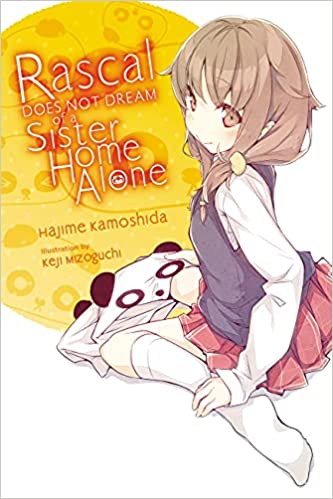By Hajime Kamoshida and Keji Mizoguchi. Released in Japan as “Seishun Buta Yarou wa Yumemiru Shoujo no Yume wo Minai” by Dengeki Bunko. Released in North America by Yen On. Translated by Andrew Cunningham.
In my review of the last volume in this series, I mentioned I wasn’t aware of what happened in the next two books beyond it being sad. I’ll admit: I was lying. Generally these days, if you are following a series in any capacity on the internet, and the anime has already come out, there is no real way to avoid being spoiled. I didn’t have the main story beats of this book spoiled to me, but I knew what the last five pages would be, and so they are. That said, let’s not talk about those, let’s instead discuss the previous 250 or so pages, in which we find that Sakuta’s own adolescence syndrome has a very different cause from what he (and the reader) thought, learn exactly what’s going on with Shouko, and discover that it’s still hard to say you’re different from Bakemonogatari or Oregairu when you decide the best way for the hero to fix things is to sacrifice himself to save the girl.
Sakuta’s apartment is getting a bit crowded. Kaede is back, though with her “original” personality, and is struggling to catch up with the two years she’s lost. College-age Shouko is there, being very mysterious and Kasumi Tendo-ish. And Mai stays over once as well, because frankly the situation screams “my boyfriend is cheating on me with an older woman who’s also a middle-school student”, and who among us hasn’t felt agitated when that happened to them? The drama starts then Sakuta discovers that Shouko is back in the hospital – and getting worse. She has an old elementary school assignment about dreams for the future she never completed, as “die” would upset the teachers. Now it’s mysteriously being filled out… and the details seem to match up with college-age Shouko very well. Sakuta is concerned about the “get married’ part, though…
One of the more interesting things about this series is that it has all the wacky misunderstandings that harem anime usually has, but without any of the actual misunderstandings themselves. Mai and Sakuta are simply too sympatico with each other to really believe that there’s cheating or lying going on. Indeed, the fact that they’re so in tune with each other is what leads up to the tragedy in the final pages. Other than that, the most affecting part of the book for me may not have been the ending but everything leading up to it, as Sakuta drifts through school looking like a man who’s about to die. When even Kamisato is deeply concerned with him, in her own “drop dead” way, you know things are bad. And Rio and Mai’s scenes are even worse. Everyone seems to know what’s going to happen, but they also know that talking Sakuta out of this is next to impossible. As indeed it proves to be.
So what’s next? Well, if this were the movie, we’d only be halfway done. But it’s a book, so we’ve got to wait a few months. Rest assured I doubt it will kill off a main character, but I’m not as optimistic about its dreaming girl. Till then, enjoy an emotional gut-wrencher.



